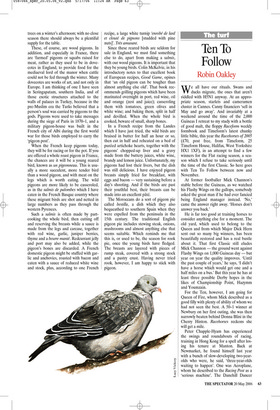Always around
Simon Courtauld
There never seems to be any shortage of pigeons. Whether feeding in a field of corn or rape by day or coming into woodland at dusk, they are always around. Depending on the weather and the time of day, you may have to wait a while for them, but, as William Douglas-Home once wrote in a memorable article for the Field on pigeon-shooting, ‘they always turn up in the end’. They may be shot over decoys in spring and summer or from the shelter of trees on a winter’s afternoon; with no close season there should always be a plentiful supply for the table.
These, of course, are wood pigeons. In addition, and especially in France, there are ‘farmed’ pigeons or squabs raised for meat, rather as they used to be in dovecotes in England, to provide food for the mediaeval lord of the manor when cattle could not be fed through the winter. Many dovecotes are works of art, and not only in Europe. I am thinking of one I have seen in Seringapatam, southern India, and of those exotic structures attached to the walls of palaces in Turkey, because in the pre-Muslim era the Turks believed that a person’s soul was carried by pigeons to the gods. Pigeons were used to take messages during the siege of Paris in 1870–1, and a military pigeon-house was built in the French city of Albi during the first world war for those birds employed to carry the ‘pigeon post’.
When the French keep pigeons today, they will be for racing or for the pot. If you are offered a whole roast pigeon in France, the chances are it will be a young reared bird, known as un pigeonneau. This is usually a more succulent, more tender bird than a wood pigeon, and with meat on the legs which is worth eating. The wild pigeons are more likely to be casseroled, as in the salmis de palombes which I have eaten in the French Basque country where these migrant birds are shot and netted in large numbers as they pass through the western Pyrenees.
Such a salmis is often made by partcooking the whole bird, then cutting off and reserving the breasts while a sauce is made from the legs and carcase, together with red wine, garlic, juniper berries, thyme and a beurre manié. Redcurrant jelly and port may also be added, while the pigeon’s bones are discarded. A French domestic pigeon might be stuffed with garlic and anchovies, roasted with bacon and eaten with a sauce of reduced white wine and stock, plus, according to one French recipe, a large white turnip ‘enrobé de lard et clouté de pignons [studded with pine nuts]’. Très amusant.
Since these reared birds are seldom for sale in England, we must find something else to do, apart from making a salmis, with our wood pigeons. It is important that they be young birds. Colin McKelvie, in his introductory notes to that excellent book of European recipes, Good Game, opines that ‘an old pigeon can be tougher than almost anything else old’. That book recommends grilling pigeons which have been marinated overnight in port, red wine, oil and orange (zest and juice); casseroling them with tomatoes, green olives and white wine; and baking them, split in half and devilled. When the whole bird is cooked, beware of small, sharp bones.
In a French recipe from the Landes which I have just tried, the wild birds are braised in butter for half an hour or so, then cut in half and reheated on a bed of puréed artichoke hearts, together with the pigeons’ chopped-up liver and a gravy made from the buttery juices, white wine, brandy and lemon juice. Unfortunately, my pigeons had lost their livers, but the dish was still delicious. I have enjoyed pigeon breasts simply fried for breakfast, with eggs and bacon — very sustaining before a day’s shooting. And if the birds are past their youthful best, their breasts can be made into an excellent pâté.
The Moroccans do a sort of pigeon pie called bestilla, a dish which they also bequeathed to southern Spain when they were expelled from the peninsula in the 15th century. The traditional English pigeon pie includes stewing steak, onions, mushrooms and almost anything else that seems suitable. Which reminds me that this is, or used to be, the season for rook pie, once the young birds have fledged. The breasts are layered with pieces of rump steak, covered with a strong stock and a pastry crust. Having never tried rook, however, I am happy to stick with pigeon.



















































































 Previous page
Previous page